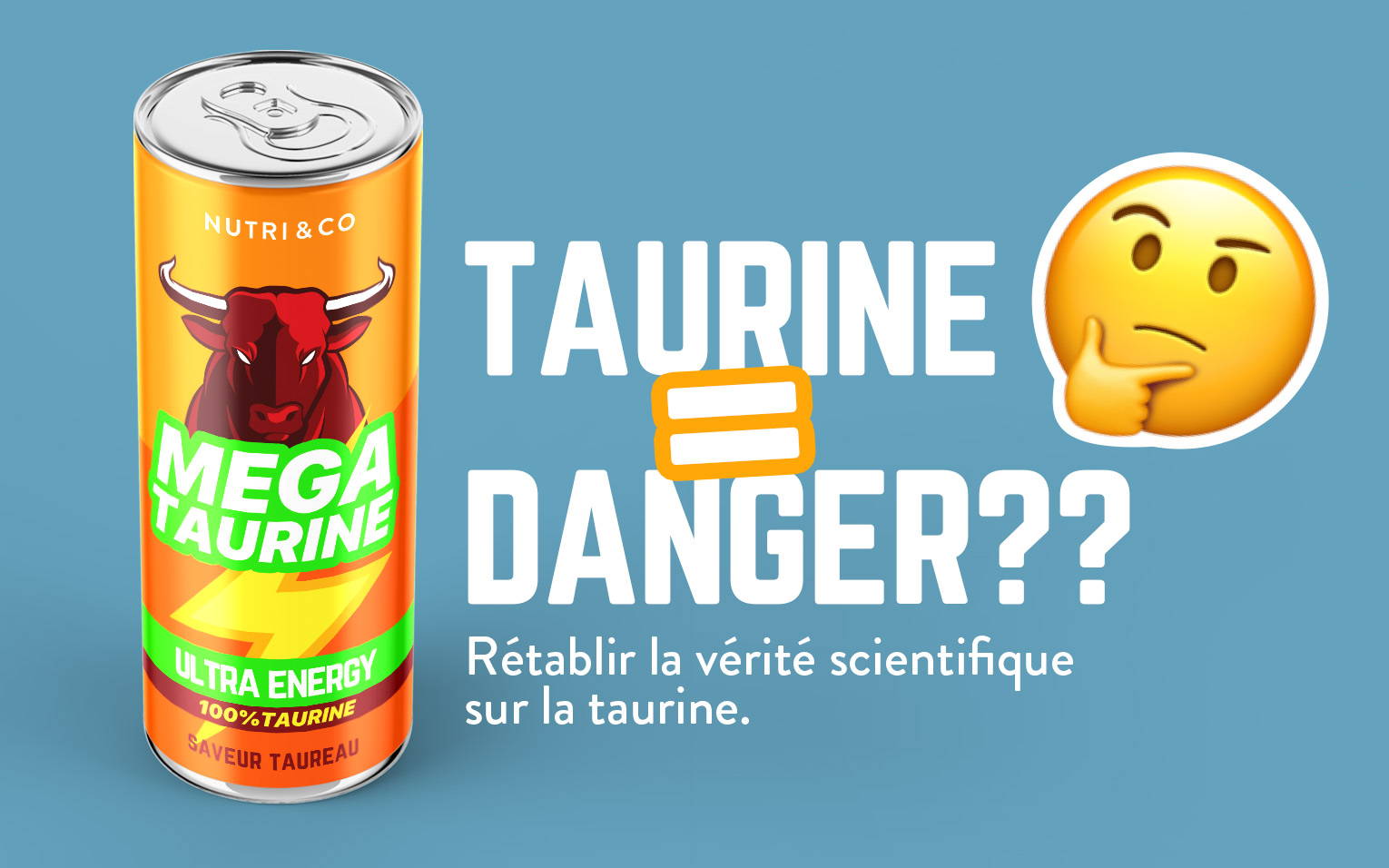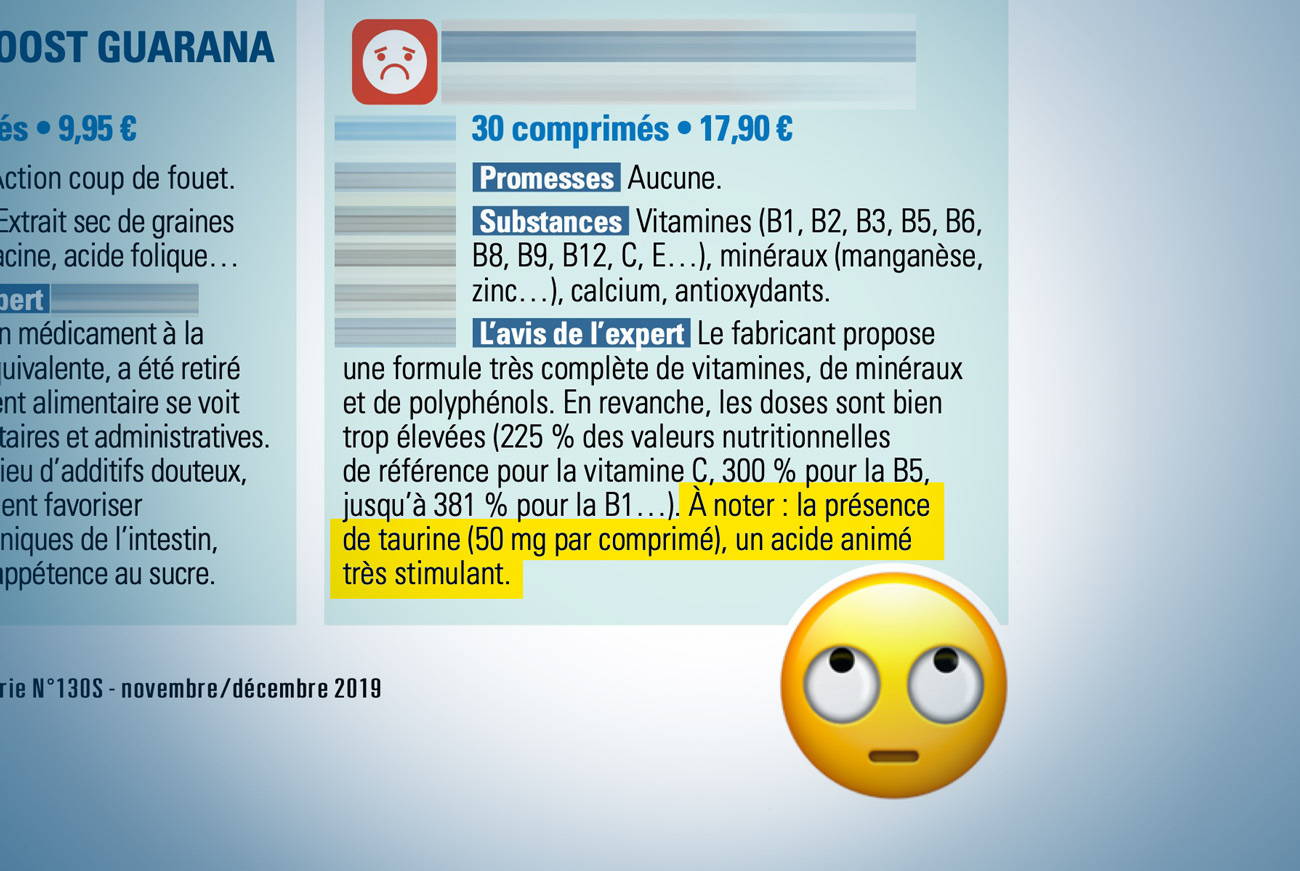
WHAT TO REMEMBER :
- Taurine has a sulphurous, even dangerous reputation.
- Several myths surround this amino acid, often associated with energy drinks.
- However, taurine is naturally present in our body.
- It is even tolerated at high doses and its functions are now considered vital, including in infants.
It's always the same story. The magazine 60 Millions de Consommateurs had just hit the headlines with a shocking article: "Food Supplements: Vigilance is the way to go". After a dozen pages of anxiety-provoking articles questioning the entire industry, several experts were shelling out a hundred or so products on the market and awarding good and bad points. Bad product? PAF, unhappy smiley face and red (with a little "sick" look on his face). Good product, rarer, green and smiling smiley, everything is fine. Expedited.
We were about to pass our way after the observation that nothing changes, when we came across the ultimate aberration, one too many slips, the famous drop that makes the vase overflow.

The multivitamin of a colleague punished by a red smiley face because it contains taurine: "a very stimulating amino acid". One could have imagined a mixed smiley face (this one is yellow), because of the not always bio-active forms of the vitamins, or a criticism for the use of Manganese. But no, the expert attacked taurine... Enough is enough, we had to react.
What's the taurine first ?
For yes, it is high time to set the record straight, once and for all, about the taurine. This amino acid is made by the body but also provided by food. It is often found in energy drinks, but is also associated with magnesium in nutraceuticals. Taurine acquired its amino acid status through its function rather than its structure, which is not strictly speaking that of an amino acid. In fact, taurine does not contain a carboxylic acid, but a sulfonic acid, with a sulfur atom, so... Review of the 4 main myths about this molecule which has a reputation for being sulfurous, to say the least.../p>
Myth number 1 : Taurine is extracted from the testicles of bulls.
FALSE : Taurine is so called because it was discovered by the German scientists Friedrich Tiedemann and Leopold Gmelin in the bile of beef or bull. Today this amino acid is no longer obtained by extraction from the entrails of poor animals, it is of synthetic origin, which means that even vegetarians and vegans can consume it. But still, we have to admit that Taurine ➔ Bull ➔ Testicles ➔ Force is a very attractive mental shortcut.
Myth number 2 : Taurine = danger
FALSE : the taurine's reputation went to the dark side with the introduction of energy drinks. It is now known that it is the sometimes excessive amount of caffeine in these drinks that has been shown to cause adverse neurological effects. Studies have also shown that taurine is tolerated at high doses of up to several grams per day (1). So unless you drink more than 20 cans of energy drink in a day (pure madness, let's face it), you're safe from an overdose of taurine... phew.
Myth number 3 : Taurine gives wings
FALSE : what gives you wings is the mix of caffeine and high-dose sugars. It turns out that taurine is only there to mitigate nervousness, trembling or palpitations (the famous "gitters" effect) caused by stimulants such as caffeine. Basically, it would help the body to channel the boost effect and the overdose of energy (2).
Myth number 4 : Taurine is a sedative
FALSE : Taurine plays several roles in the body and is very present in the heart and muscles (3). It plays a role in the regulation of intracellular calcium (4), which helps to reduce nervousness, and acts as a neurotransmitter (like GABA), again an action related to nervousness (5). If we have to choose a "neurological" effect (with tweezers in addition to the quotation marks), we can therefore speak of an "anti-nervous" effect. Taurine is often associated with magnesium for a synergistic effect (6), (7). And since you have read in our article on calcium, you know that limiting calcium favors magnesium. QED.
What are the effects of taurine ?
NO, taurine does not come from the testicles of bulls, it is not toxic and does not give wings either. In energy drinks, it acts as a "channel" for the extra excitement generated by caffeine. In the body, its roles are multiple and sometimes still obscure, even though it is known to be present in many tissues. Its central role and its high dose tolerance make it a perfect candidate for research in nutra, but also in pharma, in fields as varied as sports such as weight training or endurance (8) or mitochondrial diseases (9). For those who want to learn more about taurine and its effects, because it deserves it, the literature is extensive (10).
Gentlemen "experts", here is a small suggestion: in the future before judging, start from the beginning and ask yourself a simple first question: what is taurine? Then go and check your preconceived ideas on this little site that is worth knowing: www.wikipedia.org. You will have seen that there is 42 mg of taurine per litre of breast milk, and that some manufacturers even add some to infant milk (11). But why do they therefore want to stimulate our little children very strongly with taurine?!??? SOS Conspiracy! Quick, a shock folder and an angry red smiley face!
1. « La Taurine et les boissons énergisantes », Pierre-Yves Tremblay, Bulletin d’information toxicologique 26 (1), 2010
2. « Effect of taurine and potential interactions with caffeine on cardiovascular function », Stephen W Schaffer et al., Amino Acids 46 (5), 2014
3. « Physiological roles of taurine in heart and muscle », Stephen W Schaffer et al., Journal Of Biomedical Science 17 (1) S2, 2010
4. « Taurine modulates calcium influx through L-type voltage-gated calcium channels in isolated cochlear outer hair cells in guinea pigs », Liu Hy et al., Neuroscience Letters 399 (1-2), 2006
5. « Taurine modulates calcium influx through L-type voltage-gated calcium channels in isolated cochlear outer hair cells in guinea pigs », Lenin Ochoa-De la Paz et al., Expert Review Of Neurotherapeutics 19 (4), 2019
6. « Audiogenic seizures in magnesium-deficient mice: effects of magnesium pyrrolidone-2-carboxylate, magnesium acetyltaurinate, magnesium chloride and vitamin B-6 », Bac P et al., Magensium Research 6 (1), 1993
7. « Reversible model of magnesium depletion induced by systemic kainic acid injection in magnesium-deficient rats: I--Comparative study of various magnesium salts », Bac P et al., Magensium Research 9 (4), 1996
8. « The Effects of an Oral Taurine Dose and Supplementation Period on Endurance Exercise Performance in Humans: A Meta-Analysis », Waldron M. et al., Sports Medicine 48 (5), 2018
9. « Effects and Mechanisms of Taurine as a Therapeutic Agent », Stephen Schaeffer et al., Biomolecules & Therapeutics 26 (3), 2018
10. « Taurine in health and diseases: consistent evidence from experimental and epidemiological studies », Yukio Yamori et al., Journal of Biomedical Science 17 (S6), 2010
11. « The Role of Taurine in Infant Nutrition », Chesney RW et al., Advances in Experimental Medicine and Biology, 442, 1998







